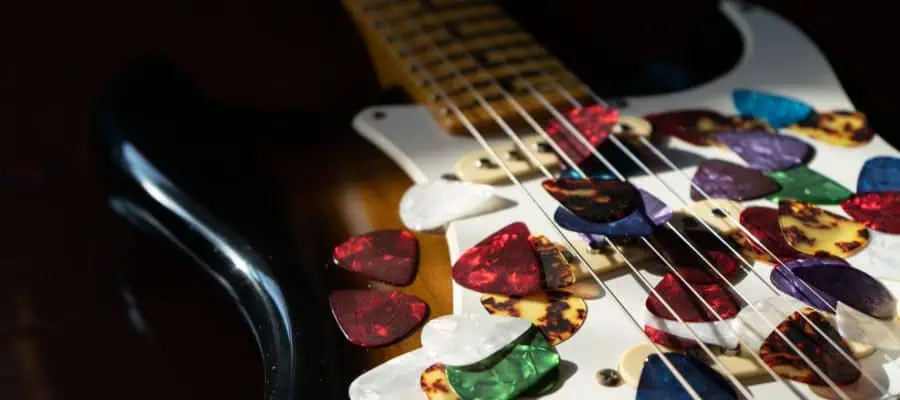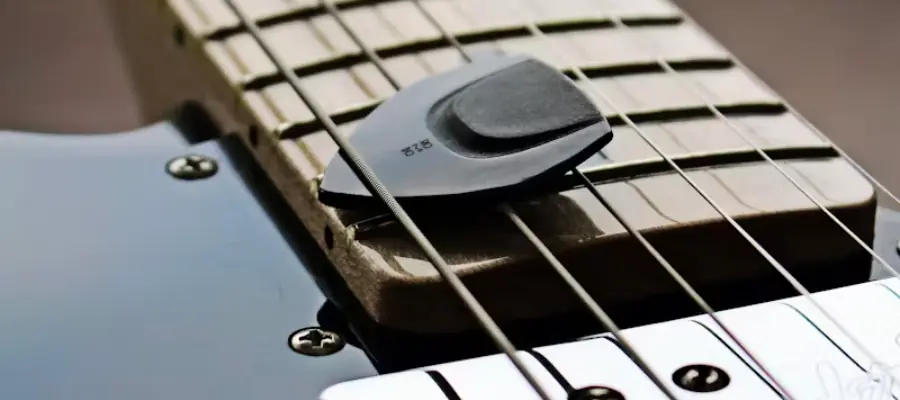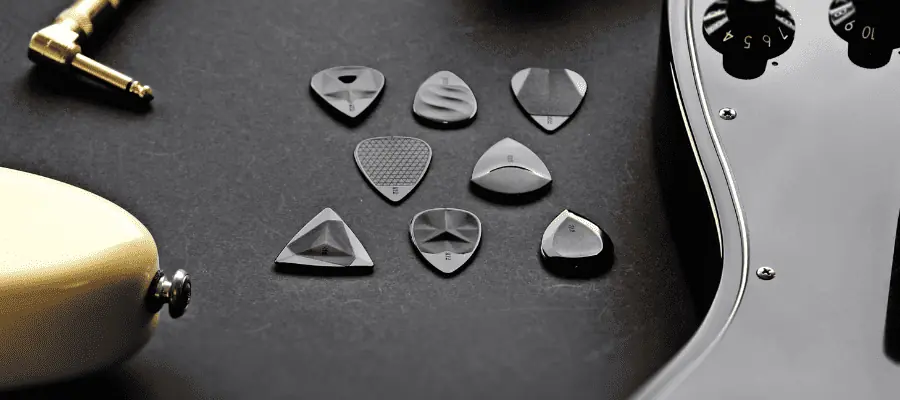When learning to play the guitar, you typically use a pick since it’s helpful for strumming and easier to use against the strings. With time, you may learn how to play with your fingers, but picks remain a staple for several different playing styles. You may have noticed that some guitar picks are pretty expensive, especially considering how small and simple they look; why does this happen?
Some guitar picks are more expensive because they are made of more durable or sustainable materials or by hand. Also, they may cost more because they are simply made by a well-known brand or have more value as collectibles. Guitar pick prices start from a few cents and can go up to a few hundred dollars.
In the rest of this article, I will explain what factors affect the price of guitar picks and show you different price points. Moreover, I will explain more about different types of guitar picks and how they can affect the way you lay.
Factors That Affect the Cost of Guitar Picks

Guitar picks seem quite simple at first glance. They are triangular pieces of plastic with rounded corners that you use to strum the strings of your guitar. These picks are typically made of a single, uniform material and are pretty small, so what exactly makes some picks so costly?
You need to keep a few factors in mind when considering the cost of a guitar pick.
First, you should consider the material; most guitar picks are made of plastic, but others are made of other environmentally friendly materials, which can cost more. Additionally, the type of plastic also plays a role; nylon picks cost less than celluloid ones because the latter is more challenging to produce.
The second factor you should remember is the labor that goes into manufacturing every single pick. Picks should be molded, beveled, polished, and then etched with a particular design. Every step of the process can be costly, especially when done by hand.
Finally, the branding of the picks also adds to the overall price. Certain well-known guitar brands also produce picks that are not that different from those of unknown brands. However, their name and reputation can affect the price as well, which is why Gibson, Martin, or Fender guitar picks are more expensive than others.
Why Some Guitar Picks Cost More Than Others
As you can see, there are a few different aspects that you need to keep in mind when calculating the cost and price of a guitar pick. A simple, mass-produced nylon pick may cost much less than a handmade metal or composite guitar pick from a well-known producer.
Some guitar picks are expensive because they are made of more durable materials or molded or finished by hand. Others are more expensive simply because they are made by a popular brand.
Do Guitar Picks Wear Out?

Depending on the material, guitar picks will wear out eventually. Picks go through rough conditions as you strum chords or play solos, making the picks make repetitive contact with steel strings.
Materials such as Delrin, Ultex, and Nylon have longer lifespans, while Celluloid picks wear out quicker. The lifespan of picks also depends on the thickness and your playing style. If you have a more aggressive playing style, your picks will wear out faster.
You can check out your pick to see if
How Much Do Guitar Picks Typically Cost?

As I explained above, you should consider the material, labor, method of production, and brand recognition when you calculate the cost and price of a guitar pick. Depending on the specific combination of these factors, some picks cost much more and others much less:
- For instance, the most common mass-produced nylon picks can cost as little as a few cents and as much as a couple of dollars per pick.
- Celluloid picks, made of a stronger material, can cost a bit more, but still not more than a couple of dollars per pick.
- Metal picks are more sustainable and environmentally friendly, not to mention more resistant, so they cost a bit more. You can find metal picks that cost up to $20 in certain cases.
- Understandably, picks that are molded or polished by hand are also more expensive. These picks are typically made by artisanal local companies and can cost more than $20 or $30, especially if they are made of more durable materials.
- Well-known guitar brands such as Gibson may also offer pricier picks, but they include plenty of affordable options as well. A single brand-name pick may cost somewhere between $3 and $50, depending on the material, production method, and collectability.
Are Some Guitar Picks Overpriced?
Some guitar picks can cost more than $200, which may seem unreasonable to you. Most people often consider anything more than $5 per pick overpriced because you can achieve more or less the same results with a pick that only costs a few cents.
There is no right or wrong answer to this question. What seems overpriced to you may be a bargain for someone else. Some rare collectible picks have a lot of value to collectors but are the same as any other pick to you. Most guitarists are fine with common, cheap guitar picks.
Does Your Pick Make a Difference in the Way You Play?

Your guitar pick is essential for your guitar playing because it is responsible for producing the sounds in the right way. While it may seem like any pick would do for such a simple movement, the truth is that the quality, shape, and material of the pick can make a significant difference in the way you play.
Professional guitarists may take a while to select and explore different picks to see which one is more comfortable and effective for their style. They pay attention to the shape and strength of the material but also the durability; some picks are not as resistant and may not work properly after a while.
For example, thicker picks are preferred for more aggressive genres like hard rock and metal, as well as for faster playing styles. Thicker picks provide more control and a rounder sound, which is good for shredding solos and heavy riffs. On the other hand, thinner picks provide a crisper sound and are good for playing multiple notes and chords due to their flexibility.
Another factor is the pick shape. The shape affects how the pick contacts with the strings as well as your grip. Sharper picks with beveled points are better for shredding playing styles, while rounded points are better for moving around the strings freely, making them better choices for playing chords. Smaller shapes are preferred for picking efficiency for faster playing styles, but some players find them uncomfortable as their fingers catch the strings.
Additionally, the individual playing style may also require a specific type of pick. If you’re just learning to play the guitar, you can choose the cheapest possible option, and you’ll be fine. However, if you’re playing regularly, you may need to select more durable materials for longevity; a slightly more expensive but durable pick will cost less in the long run.
Conclusions
Guitar picks seem relatively simple, but they can cost up to hundreds of dollars. Some picks are costly because they are made of very durable materials, are made by hand, are made by a well-known brand, or are collectible.
As an amateur, you don’t need to spend much time considering prices and materials; a typical nylon pick will do the job in most cases. A celluloid one can be more durable if you play regularly. Professional guitarists consider the pick’s comfort and accuracy to ensure they can use it for a long time.
If you found this article useful, you may want to save this pin below to your Guitar board.

Recent Posts
When learning new songs have you noticed that some of the chord sequences sound really good? But when you tried to come up with your own chord sequence, or as we call it chord progression, you found...
Some guitarists insist on buying an expensive amplifier with their electric guitar. They assume that this is a must for every type of guitarist out there. However, in some situations, this isn’t...

